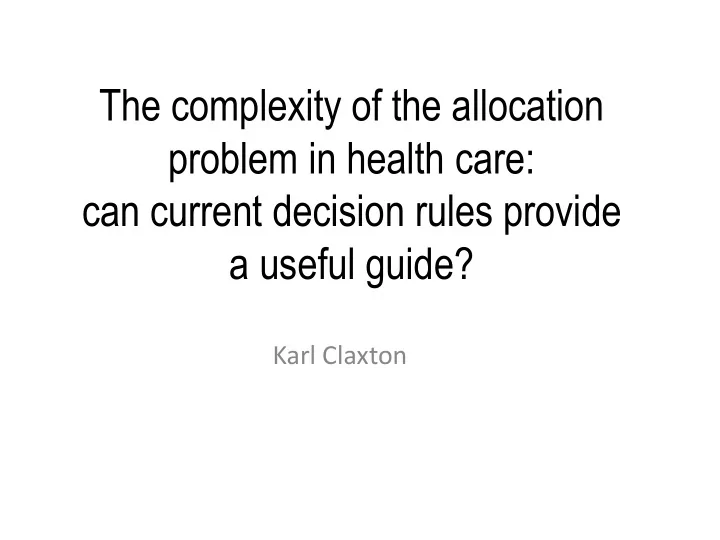

The complexity of the allocation problem in health care: can current decision rules provide a useful guide? Karl Claxton
Questions of fact and questions of value? When costs displace health (∆ c h ) • . c c v c h c h h 0 v h c or k 0, h k v k h Health Health Consumption gained forgone forgone When costs displace consumption (∆c c ) • c c . c h c h 0 c v h c 0, or v c k v h Health Consumption forgone forgone Costs fall on both • k c c c c h c v v h c h 0 k v h c c or . 0, h c k v h k Fact : k = how much health displaced by increased HCS costs? Value: v = how much consumption should we give up for health?
Question of value Claxton et al, 2010 , 2011 and Paulden 2011 • Specify a complete and legitimate SWF? – v is the measure of social welfare and presupposes a complete SWF • Health and consumption are the only arguments • or separable from other arguments – k is simply an inefficient nuisance preventing welfare maximisation • Complete and legitimate specification of SW not possible? – Trade-offs still need to be and are made – Legitimate social process reveals something about a latent welfare function – Interpret shadow prices as revealed but partial expression of social value • k is a revealed expression of social value of health from collective health care • v is how much of their consumption individuals are willing to give up to improve their own healt h – So good reasons why k ≠ v – Good reasons to suppose there are other non separable arguments
What it is and what its not An efficient NHS Health 1/k 1 Underestimate health effect of ∆B (i.e., k 1 is too high) Current NHS 1/k 1 Average productivity would H1 overestimate health effect of ∆B (i.e., H1/B1 < k 1 ) Budget B1
A scientific question of fact Martin et al 2008, 2009 and MRC/NIHR 2012 • Previously – Variations in expenditure and outcomes within programmes – Reflect what actually happens in the NHS by PBC Cancer Circulation Respiratory Gastro-int 04/05 per LY £13,137 £7,979 05/06 per LY £13,931 £8,426 £7,397 £18,999 • Need estimate the overall threshold: – How changes in overall expenditure gets allocated across all the programmes – How changes in mortality might translate into QALYs gained – More (all) programmes (types of QALYs displaced) – How uncertain is any overall estimate – How it changes with scale of expenditure change – How it changes over time
Budgetary policies and available actions Chalabi et al 2008, and McKenna et al 2010 Hard constraints with uncertain and variable costs and outcomes • Corner solutions or exogenous parameters – • Model budget, policy, information revealed and available actions – Current rules special case of soft constraint – No simple ex-ante rules – more cost-effective if hard constraint not meet budget at expectation or maximise expected health outcomes • 6800 5000 Soft budget constraint 6600 4900 Hard budget constraint Expected total health benefits Expected total health benefits Complete flexibility 6400 4800 Restrictive action 6200 4700 6000 4600 5800 4500 5600 4400 5400 4300 5200 5000 4200 9 10 11 12 13 14 15 16 17 18 15 16 17 18 19 20 21 22 23 24 25 Notional budget (£ million), actual budget = £12m Budget (£ million)
Implications for the value of research Chalabi et al 2008, and McKenna et al 2010 How much budget give up to resolve uncertainty? • Underestimate value (hard constraints and less available actions) – Overestimate (soft constraint) – • EVI based on current decision rules are a special case – Soft constraint and buy as much health as you like at a constant rate (k) Variability and uncertainty matters • Approval and research decisions – £10,000,000 £3,000,000 £9,000,000 Hard budget constraint Standard EVPI £2,500,000 Restrictive action Soft budget constraint £8,000,000 EVPI in monetary terms EVPI in monetary terms £7,000,000 £2,000,000 £6,000,000 £1,500,000 £5,000,000 £4,000,000 £1,000,000 £3,000,000 £2,000,000 £500,000 £1,000,000 £0 £0 0 5 10 15 20 25 30 35 40 0 5 10 15 20 25 30 35 40 45 50 Budget (£ million) Budget (£ million)
McKenna and Claxton 2011 Irrecoverable (opportunity) costs and MRC/NIHR 2011 Irrecoverable per patient treatment costs (NHE profile) • • Irrecoverable costs allocated over time (e.g., capital costs of equipment) 5,000 Y , QAL 0 Cumulative incremental NHE at population level for EECP 0 5 10 15 20 25 30 35 40 45 50 -5,000 Capital cost spread over 10 years Capital cost incurred in year 1 -10,000 -15,000 -20,000 Technology time horizon -25,000 Time, years
Griffin et al 2011 and Irrecoverable (opportunity) costs MRC/NIHR 2011 • Research is not possible with approval (incentives and ethics) Irrecoverable opportunity cost (value of information forgone) • 0.0 Sufficient condition for Approve Probability that research is conducted 0.2 0.4 Necessary condition for OIR 0.6 4-year design 3-year design 0.8 2-year design 1-year design 1.0 0 1 2 3 4 5 6 7 8 9 Time for research to report, years
Up a creek without a paddle? Where does this leave us? • Cant fully specify SWF anyway – At best partial reflection of social value (cant claim efficient/optimal) – Contribute to accountable decisions and progressive change • No ‘optimal’ simple ex -ante rules – Depends on budget, policy, what is revealed and when, and remedial actions available – Problem of second best (problem for traditional CBA as CEA) – Understand the limitations and implications • Account for irrecoverable opportunity costs (price thresholds) – Reject to approve (only relevant if no uncerinty) – Reject to OIR, OIR to Approve (research not possible) – Reject to OIR, OIR to AWR, and AWR to Approve
Recommend
More recommend